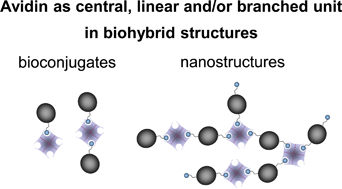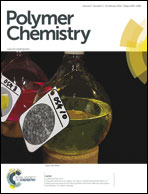Biohybrid structures consisting of biotinylated glycodendrimers and proteins: influence of the biotin ligand's number and chemical nature on the biotin–avidin conjugation†
Abstract
We present the bioconjugation of avidin as a central and/or bridging building block with mono-, bi- and tetravalent biotinylated glycodendrimers to fabricate defined supramolecular nanostructures for future (bio)medical applications. For this purpose mono-, bi- and tetravalent biotinylated glycodendrimers, decorated with short alkyl-linked or long PEG-linked biotin ligands, were synthesized and characterized by NMR, IR and mass spectrometry and HABA displacement assay. Various techniques (UV/Vis, DLS, TEM, LILBID-MS and AF4) were used in order to obtain information about the structural properties of different conjugates of avidin and mono-, bi- and tetravalent biotinylated glycodendrimers. The biotin ligand's spacer length, its chemical structure and the degree of biotin functionalization are essential parameters in the formation of nanostructures with avidin having a controlled composition and size dimension up to 100 nm. Biohybrid structures with avidin as a central unit require monovalent glycodendrimers with PEG-linked biotin, while bi- and tetravalent glycodendrimers with short alkyl-linked biotin ligands are more efficient than their counterparts with longer PEG–biotin ligands in the fabrication of defined biohybrid structures (∅ up to 100 nm) with avidin as a bridging unit. The most dominating key issue, combined with other conjugation issues, is the optimal ligand–receptor stoichiometry to fabricate biohybrid structures with diameter of <20, <30 or up to 100 nm.


 Please wait while we load your content...
Please wait while we load your content...